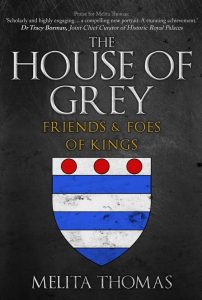‘The Grey family was one of medieval England’s most important dynasties. They were were on intimate terms with the monarchs and interwoven with royalty by marriage. They served the kings of England as sheriffs, barons and military leaders. In Henry IV’s reign the rivalry between Owain Glyndwr and Lord Grey of Rhuthun was behind the Welsh bid to throw off English dominance. His successor Edmund Grey played a decisive role at the Battle of Northampton when he changed allegiance from Lancaster to York. He was rewarded with the disputed lands and the earldom of Kent. By contrast his cousin, Sir John Grey, died at the second battle of St Albans, leaving a widow, Elizabeth née Woodville, and two young sons, Thomas and Richard. Astonishingly, the widowed Elizabeth caught the eye of Edward IV and was catapulted to the throne as his wife. This gave her sons an important role after Edward s death. The Greys were considered rapacious, even by the standards of the time and the competing power grabs of the Greys with Richard, Duke of Gloucester led to Richard Greys summary execution when Gloucester became king. His brother, Thomas, vowed revenge and joined Henry Tudor in exile.
When Thomas Grey’s niece, Elizabeth of York, became queen, the family returned to court, but Henry VII was wary enough of Thomas to imprison him for short time. Thomas married the greatest heiress in England, Cicely Bonville, their numerous children gained positions in the court of their cousin, Henry VIII, and his daughter, Mary. The 2nd Marquis was probably taught by Cardinal Wolsey but was a vigorous supporter of Henry VIII s divorce from Katharine of Aragon. But his son’s reckless involvement in Wyatt s rebellion ended in his own execution and that of his daughter, Lady Jane Grey, the ‘Nine Days Queen’. Weaving the lives of these men and women from a single family, often different allegiances, into a single narrative, provides a vivid picture of the English mediaeval and Tudor court, reflecting how the personal was always political as individual relationships and rivalries for land, power and money drove national events.
Further details – Amberley Publishing
Further details – Amazon.co.uk


































